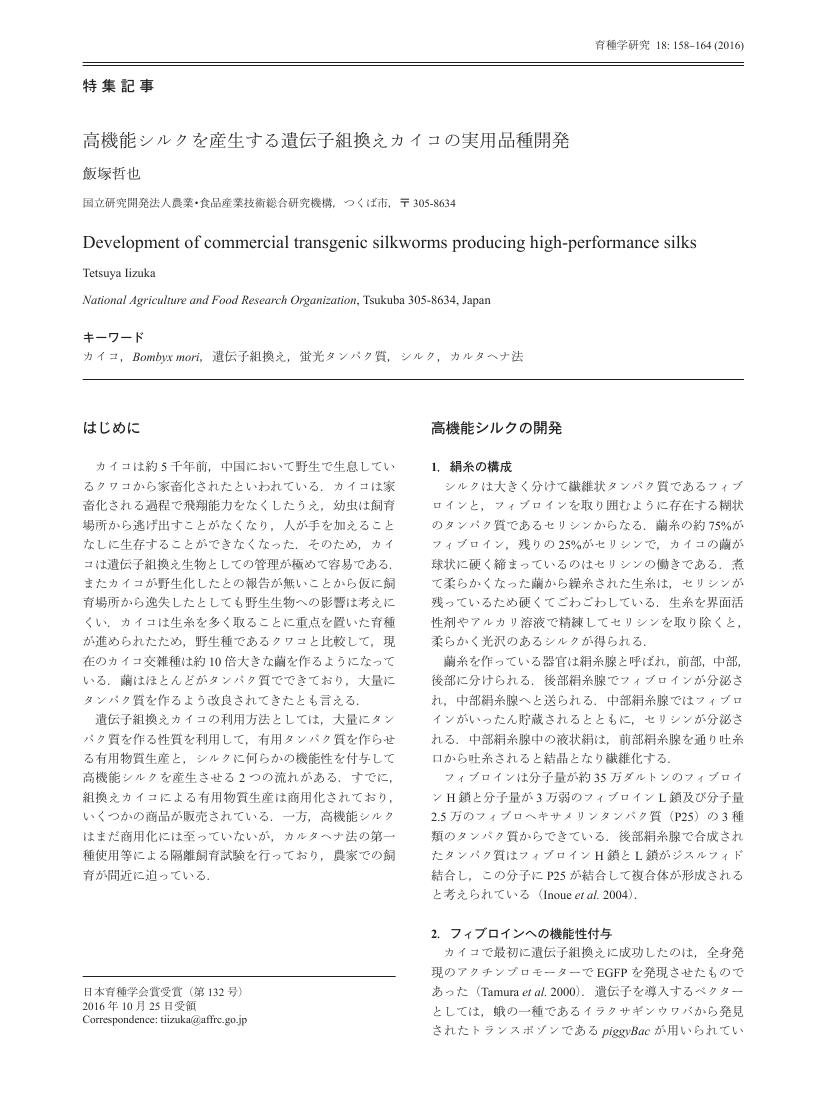3 0 0 0 OA 遺伝子組換えカイコによる医薬品開発プラットフォームの構築
- 著者
- 瀬筒 秀樹 笠嶋(炭谷) めぐみ 近藤 まり 小林 功 高須 陽子 鈴木 誉保 米村 真之 飯塚 哲也 内野 恵郎 田村 俊樹 坪田 拓也 立松 謙一郎
- 出版者
- 公益社団法人 日本薬学会
- 雑誌
- YAKUGAKU ZASSHI (ISSN:00316903)
- 巻号頁・発行日
- vol.138, no.7, pp.863-874, 2018-07-01 (Released:2018-07-01)
- 参考文献数
- 33
- 被引用文献数
- 6
We have been constructing a platform for the development of pharmaceutical and medical applications using the domesticated silkworm, Bombyx mori, as a new animal model for drug development and evaluation. Because silkworm larvae originally have the capacity to synthesize up to 0.5 g of silk proteins, genetically modified silkworms (transgenic silkworms) are expected to have high potential in the production of recombinant silks/proteins. An innovative method for generating transgenic silkworms was established in 2000, and ever since this epoch-defining technological development, longstanding efforts have succeeded in developing novel silks that enable the manufacture of new textile materials for regenerative medical uses. Furthermore, we have succeeded in developing a new system of recombinant protein production. This recombinant protein production system is currently capable of producing a maximum of approximately 15 mg recombinant protein per silkworm larva. Transgenic silkworms have also been shown to produce a wide variety of useful proteins, including antibodies and membrane proteins. Some of these recombinant proteins have been in commercial use since 2011. In addition, we have been developing transgenic silkworms as a novel animal model for testing medicines based on metabolic similarities between silkworms and mammals. These applications show the suitability and potential of transgenic silkworms for medical use. Here, we will describe the challenges faced in creating a transgenic silkworm-based platform for pharmaceutical and medical applications.
2 0 0 0 OA 日本におけるクワコの生息地域:フェロモントラップを用いた調査
- 著者
- 河本 夏雄 行弘 研司 木内 信 阪口 洋樹 和田 旭紘 伊藤 雅信 小瀬川 英一 中村 匡利 池田 真琴 木内 彩絵 桑原 伸夫 金児 雄 比留間 潔 水谷 信夫 浅野 眞一郎 石橋 純 飯塚 哲也 神村 学 志村 幸子 瀬筒 秀樹 冨田 秀一郎
- 出版者
- 社団法人 日本蚕糸学会
- 雑誌
- 蚕糸・昆虫バイオテック (ISSN:18810551)
- 巻号頁・発行日
- vol.88, no.1, pp.1_053-1_063, 2019 (Released:2019-05-16)
- 参考文献数
- 24
We surveyed the distribution of the wild mulberry silkmoth, Bombyx mandarina, using pheromone traps. Male moths were captured in all the prefectures of Japan except Okinawa Prefecture. In Tokara Islands, B. mandarina inhabits Nakanoshima and Akusekijima Islands while it is absent in Takarajima Island, which lies to the south of the Watase line. No Bombyx moths were captured in Iki, Amami, and Okinawa Islands. In addition, we collected B. mandarina in Hachijo Island for the first time. 1) Institute of Agrobiological Sciences, National Agriculture and Food Research Organization, 1-2 Owashi, Tsukuba, Ibaraki 305-8634, Japan; 2) Department of Applied Biology, Kyoto Institute of Technology, Matsugasaki, Sakyoku, Kyoto, 606-8585, Japan; 3) Genetic Resource Center, National Agriculture and Food Research Organization, 6585 Kobuchisawa, Hokuto, Yamanashi, 408-0044, Japan; 4) Gunma Sericultural Technology Center, 2326-2 Soja, Soja-machi, Maebashi, 371-0852, Japan; 5) Faculty of Agriculture and Life Sciences, Hirosaki University, Hirosaki 036-8561, Japan; 6) Kyushu Okinawa Agricultural Research Center, National Agriculture and Food Research Organization, 2321 Suya, Koshi, Kumamoto 861-1192, Japan; 7) Graduate School of Agriculture, Hokkaido University, Sapporo, Hokkaido, 060-8589, Japan.
1 0 0 0 OA 遺伝子組換えカイコの飼育における生物多様性影響の評価手法の構築
- 著者
- 河本 夏雄 津田 麻衣 岡田 英二 飯塚 哲也 桑原 伸夫 瀬筒 秀樹 田部井 豊
- 出版者
- 社団法人 日本蚕糸学会
- 雑誌
- 蚕糸・昆虫バイオテック (ISSN:18810551)
- 巻号頁・発行日
- vol.83, no.2, pp.2_171-2_179, 2014 (Released:2014-11-03)
- 参考文献数
- 20
養蚕業の振興とカイコを用いた新産業創出のため,蛍光を発するなど付加価値の高い絹糸を生産する遺伝子組換えカイコの開発が進められている。遺伝子組換えカイコを養蚕農家で飼育するための第一種使用規程の承認を得るには,生物多様性への影響が高まることがないことを示す必要がある。カイコは本来,野外で自立的に生存・繁殖することはないが,近縁野生種であるクワコとの交雑による影響を考慮することが求められる。養蚕農家でカイコが屋外に出るのは飼育残渣に幼虫が混入する場合であり,それを想定して屋外にカイコを放飼したところ,鳥類やアリ類等による捕食を受けることにより,交雑可能な成虫が生じることがないことが明らかになった。また,遺伝子組換えカイコの行動特性の評価として,幼虫の行動範囲と雌成虫の産卵範囲を調査する手法を開発した。有害物質の産生性については,遺伝子組換え植物での事例に準じた手法を適用してその有効性を示した。以上のことにより,遺伝子組換えカイコの生物多様性影響を評価する手法が構築された。
1 0 0 0 OA CCD-V90カメラ信号処理システム
- 著者
- 飯塚 哲也 恩賀 誠 鶴田 雅明 黒田 修 仙田 哲也 五十川 俊明 佐瀬 昌利 近藤 紀陽 佐藤 満 新村 勉
- 出版者
- 一般社団法人 映像情報メディア学会
- 雑誌
- テレビジョン学会技術報告 (ISSN:03864227)
- 巻号頁・発行日
- vol.11, no.10, pp.19-24, 1987 (Released:2017-10-06)
- 著者
- 宮島 たか子 山本 俊雄 間瀬 啓介 飯塚 哲也 野崎 稔 木内 信
- 出版者
- 日本蠶絲學會
- 雑誌
- 日本蠶絲學雜誌 (ISSN:00372455)
- 巻号頁・発行日
- vol.70, no.1, pp.37-42, 2001-04-27
- 被引用文献数
- 2
絹の新素材開発を目的に,イミダゾール系化合物のトリフルムゾールを投与して細繊度蚕品種の「はくぎん」及び「ほのぼの」の3眠化試験を行った。乾物重で140ppmのトリフルミゾールを添加した人工飼料を起蚕から3日間与えた場合の3眠化率は3齢ならびに4齢投与とも「はくぎん」は80%を越えたが,「ほのぼの」では30%以下と低かった。280ppm濃度になると両品種とも100%近い3眠化率を示すようになった。この「ほのぼの」の感受性が低いのは交雑親である日513号に由来することが分かった。3眠化率は4齢投与より3齢投与の方が高く,全齢経過日数は3齢投与より4齢投与の方が短くなった。3眠化蚕の繭糸質についてみると無投与区に比して繭層重の低下割合が最も高く,以下,繭重,繊度,繭糸長,繭層歩合,繭長,繭幅の順になり,繭幅より繭長の低下割合が高いので,繭形が丸みを帯びるようになった。繊度は3齢投与で「はくぎん」1.36d,「ほのぼの」1.72d,4齢投与で「はくぎん」0.99d,「ほのぼの」1.03d,と著しく細くなった。これらの3眠化蚕の産生する繭は繊度偏差も小さいので,極細の高級生糸による差別化製品の開発や医療・工業用への用途が期待される。
1 0 0 0 OA 高機能シルクを産生する遺伝子組換えカイコの実用品種開発
- 著者
- 飯塚 哲也
- 出版者
- 日本育種学会
- 雑誌
- 育種学研究 (ISSN:13447629)
- 巻号頁・発行日
- vol.18, no.4, pp.158-164, 2016-12-01 (Released:2016-12-28)
- 被引用文献数
- 3

